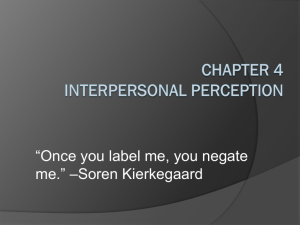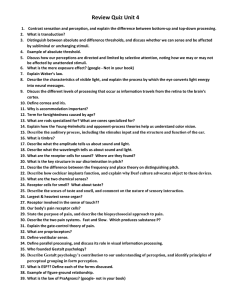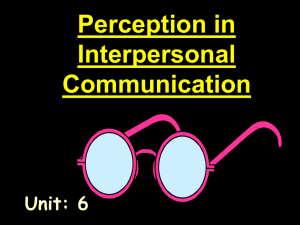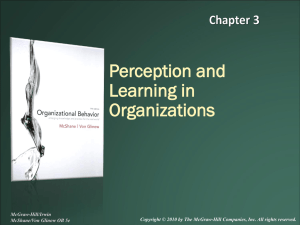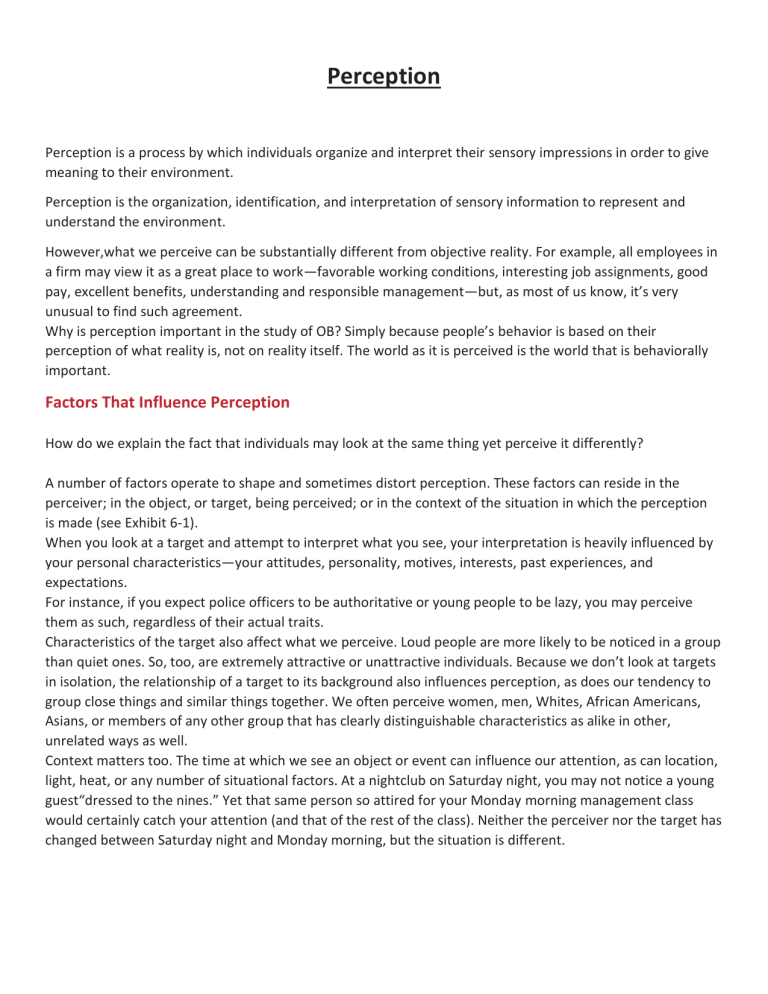
Perception Perception is a process by which individuals organize and interpret their sensory impressions in order to give meaning to their environment. Perception is the organization, identification, and interpretation of sensory information to represent and understand the environment. However,what we perceive can be substantially different from objective reality. For example, all employees in a firm may view it as a great place to work—favorable working conditions, interesting job assignments, good pay, excellent benefits, understanding and responsible management—but, as most of us know, it’s very unusual to find such agreement. Why is perception important in the study of OB? Simply because people’s behavior is based on their perception of what reality is, not on reality itself. The world as it is perceived is the world that is behaviorally important. Factors That Influence Perception How do we explain the fact that individuals may look at the same thing yet perceive it differently? A number of factors operate to shape and sometimes distort perception. These factors can reside in the perceiver; in the object, or target, being perceived; or in the context of the situation in which the perception is made (see Exhibit 6-1). When you look at a target and attempt to interpret what you see, your interpretation is heavily influenced by your personal characteristics—your attitudes, personality, motives, interests, past experiences, and expectations. For instance, if you expect police officers to be authoritative or young people to be lazy, you may perceive them as such, regardless of their actual traits. Characteristics of the target also affect what we perceive. Loud people are more likely to be noticed in a group than quiet ones. So, too, are extremely attractive or unattractive individuals. Because we don’t look at targets in isolation, the relationship of a target to its background also influences perception, as does our tendency to group close things and similar things together. We often perceive women, men, Whites, African Americans, Asians, or members of any other group that has clearly distinguishable characteristics as alike in other, unrelated ways as well. Context matters too. The time at which we see an object or event can influence our attention, as can location, light, heat, or any number of situational factors. At a nightclub on Saturday night, you may not notice a young guest“dressed to the nines.” Yet that same person so attired for your Monday morning management class would certainly catch your attention (and that of the rest of the class). Neither the perceiver nor the target has changed between Saturday night and Monday morning, but the situation is different. Perceptual Process The perceptual process is the sequence of psychological steps that a person uses to organize and interpret information from the outside world. The steps are: Objects are present in the world. A person observes. The person uses perception to select objects. The person organizes the perception of objects. The person interprets the perceptions. The person responds. The selection, organization, and interpretation of perceptions can differ among different people. Therefore, when people react differently in a situation, part of their behavior can be explained by examining their perceptual process, and how their perceptions are leading to their responses. Perceptual Selection Perceptual selection is driven by internal and external factors. Internal factors include: Personality – Personality traits influence how a person selects perceptions. For instance, conscientious people tend to select details and external stimuli to a greater degree. Motivation – People will select perceptions according to what they need in the moment. They will favor selections that they think will help them with their current needs, and be more likely to ignore what is irrelevant to their needs. Experience – The patterns of occurrences or associations one has learned in the past affect current perceptions. The person will select perceptions in a way that fits with what they found in the past. External factors include: Size – A larger size makes it more likely an object will be selected. Intensity – Greater intensity, in brightness, for example, also increases perceptual selection. Contrast – When a perception stands clearly out against a background, there is a greater likelihood of selection. Motion – A moving perception is more likely to be selected. Repetition – Repetition increases perceptual selection. Novelty and familiarity – Both of these increase selection. When a perception is new, it stands out in a person’s experience. When it is familiar, it is likely to be selected because of this familiarity. Perceptual Organization After certain perceptions are selected, they can be organized differently. The following factors are those that determine perceptual organization: Figure-ground – Once perceived, objects stand out against their background. This can mean, for instance, that perceptions of something as new can stand out against the background of everything of the same type that is old. Perceptual grouping – Grouping is when perceptions are brought together into a pattern. Closure – This is the tendency to try to create wholes out of perceived parts. Sometimes this can result in error, though, when the perceiver fills in unperceived information to complete the whole. Proximity – Perceptions that are physically close to each other are easier to organize into a pattern or whole. Similarity – Similarity between perceptions promotes a tendency to group them together. Perceptual Constancy – This means that if an object is perceived always to be or act a certain way, the person will tend to infer that it actually is always that way. Perceptual Context – People will tend to organize perceptions in relation to other pertinent perceptions, and create a context out of those connections. Each of these factors influence how the person perceives their environment, so responses to their environment can be understood by taking the perceptual process into account. Attribution Theory Nonliving objects such as desks, machines, and buildings are subject to the laws of nature, but they have no beliefs, motives, or intentions. People do. That’s why when we observe people, we attempt to explain why they behave in certain ways. Our perception and judgment of a person’s actions, therefore, will be significantly influenced by the assumptions we make about that person’s internal state. Attribution theory tries to explain the ways in which we judge people differently, depending on the meaning we attribute to a given behavior.1 It suggests that when we observe an individual’s behavior, we attempt to determine whether it was internally or externally caused. That determination, however, depends largely on three factors: (1) distinctiveness, (2) consensus, and (3) consistency. First, let’s clarify the differences between internal and external causation, and then we’ll elaborate on each of the three determining factors. Internally caused behaviors are those we believe to be under the personal control of the individual. Externally caused behavior is what we imagine the situation forced the individual to do. If one of your employees is late for work, you might attribute that to his partying into the wee hours and then oversleeping. This is an internal attribution. But if you attribute lateness to an automobile accident that tied up traffic, you are making an external attribution. Now let’s discuss the three determining factors. Distinctiveness refers to whether an individual displays different behaviors in different situations. Is the employee who arrives late today also one who regularly “blows off” commitments? What we want to know is whether this behavior is unusual. If it is, we are likely to give it an external attribution. If it’s not, we will probably judge the behavior to be internal. If everyone who faces a similar situation responds in the same way, we can say the behavior shows consensus. The behavior of our tardy employee meets this criterion if all employees who took the same route were also late. From an attribution perspective, if consensus is high, you would probably give an external attribution to the employee’s tardiness, whereas if other employees who took the same route made it to work on time, you would attribute his lateness to an internal cause. Finally, an observer looks for consistency in a person’s actions. Does the person respond the same way over time? Coming in 10 minutes late for workis not perceived in the same way for an employee who hasn’t been late for several months as it is for an employee who is late two or three times a week. The more consistent the behavior, the more we are inclined to attribute it to internal causes. Exhibit 6-2 summarizes the key elements in attribution theory. It tells us, for instance, that if an employee, Kim Randolph, generally performs at about the same level on related tasks as she does on her current task (low distinctiveness), other employees frequently perform differently—better or worse— than Kim on that task (low consensus), and Kim’s performance on this current task is consistent over time (high consistency), anyone judging Kim’s work will likely hold her primarily responsible for her task performance (internal attribution).
